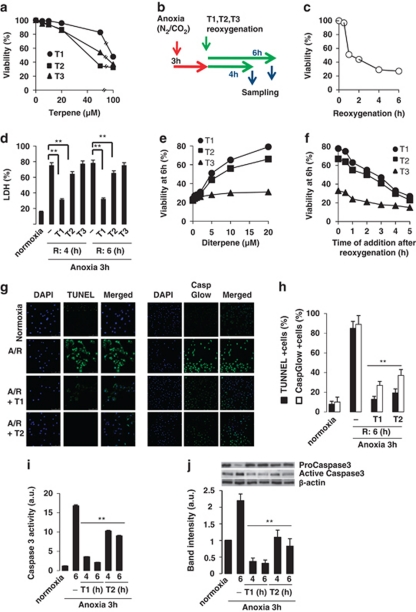Figure 2.
Labdane diterpenes protect H9c2 cells from A/R-induced injury. (a) Viability of H9c2 cells incubated for 24 h with diterpenes (0–100 μM), measured by the MTT assay. (b) Schematic diagram of the experimental protocol (T: diterpenes). (c) Time-dependent effect of reoxygenation on cell viability (MTT assay). (d) LDH release after A/R (4–6 h). Diterpenes were added prior reoxygenation. 100% LDH activity was achieved after addition of 0.5% Triton X-100 to the cell culture. **P<0.01 treatments versus Triton X-100. (e) Dose-dependent effect of diterpenes on cell viability at 6 h after A/R. (f) Effect of delayed-addition of diterpenes after A/R. Cell viability was determined by the MTT assay at 6 h after reoxygenation and expressed as cell viability (%) versus normoxic cells. (g) TUNEL positive cells (left) and caspase active positive cells (right) expressed as percentage of total cells in diterpene-treated cells versus non-treated cells. **P<0.01 compared versus A/R in the absence of diterpene. (h) In situ evaluation of caspase-3 activation. The percentage of caspase-3 positive cells was determined by fluorescence microscopy using the CaspGlow staining kit. (i) Caspase-3 activity and (j) protein levels of pro-caspase-3 and active caspase-3 were determined in cytosolic extracts from cells after A/R and treated with diterpenes T1 and T2. Lane charge was normalized with β-actin. Western blots were performed in triplicate. Results show the mean±S.D. of three experiments. **P<0.01 treatments versus A/R in the absence of diterpene

